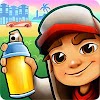For reference, here's the map (they're headed to point 4):
Having crossed the road, Frege's squad proceeded southeast towards a small war torn village. After a quick recon of the village from the edge of the fields, he split the men into two fire teams, but this time, he sent the sniper, Heidegger, forward on his own, with orders to take position inside what was hoped to be an abandoned cottage. From there Heidegger could command a view of the church and the buildings beyond the field and forest.
 |
| There is a Soviet in the church, the top left cottage, the field right top, and the ruins in front of the field. |
Unteroffizer Hegel took Carnap (grenades), Fichte (now armed with the late Schiller's grenades) and Schopenhauer into the fields northwest of the village, while Frege, Husserl(MG), Stein, and Leibnitz made for the woods to the southwest.
Turn 1
Heidegger scuttled up to the burned out building making use of every scrap of cover he could. He peered through the broken windows, listening for any sound of an enemy within.
To the right, Hegel's team crept through the field - the summer crops provided concealment but wouldn't make them invisible and caution was of the utmost importance to avoid drawing any fire from potential Soviet patrols.
With the church looming as a large and obvious choice for an enemy position, Frege ordered Leibnitz and Stein to advance through the woods and reconnoiter the church, and to keep moving to the fields beyond if able to do so
.
 |
| Heidegger outside the cottage - move was just short. Hegel's team advances on right, Stein and Leibnitz have reached the field (left center). |
 |
| Leibnitz (right) about to shoot at something in the church (never mind that there's no windows on this side. That's the model, not the actual church). |
The private was all too glad for his arrival.
Just then, off to the right from beyond the church, the crack of a rifle broke the silence.
Turn 2
Hearing Leibnitz's shot, Frege and Husserl ran forward. At the same time, Stein leapfrogged past Leibnitz to get a shot at the enemy in the church - his shots shattered glass and splintered wood, but had little other effect. Soviet return fire, an SMG, erupted from a window of the church, spraying up dirt and slicing leaves and stalks around Leibntiz..From the cottage east of the their location another Soviet SMG fired on their position.
With the sounds of a violent exchange to his front left, Hegel sent Carnap and Schopenhauer to the edge of the field to get a better shot at the church and to cover the ruined farm house due east. Almost immediately, SMG fire rang out from the dark empty windows of the farm house and Schopenhauer crashed to the dirt.
Carnap called out to Schopenhauer but received no reply.
Turn 3
[Germans won initiative but then drew a Joker for their activation.]
Turn 4
The Soviets continued firing from their defensive positions with the net effect of dropping both Stein and Leibnitz (the Germans in the fields south of the church).
Frege ordered Husserl to set up at the edge of the woods with lines of fire at the church and the ruins opposite Hegel's team. Heidegger, satisfied the cottage was abandoned, entered and crawled to a window where he finally get a shot off at the Soviets opposite Hegel's team.
 |
| Heidegger finally does something almost useful. |
Turn 5:
Sensing a desperate situation, Fichte ran forward and hurled a grenade at the farm house but the occupants were sheltered from the blast by the ruins. Poorly planned, Fichte was then exposed in the open.
From his position in the abandoned cottage, Heidegger picked out the Soviet private in the ruins through his scope. He took careful aim and then smoothly squeezed the trigger. The private slumped in his place. Before the jr. leader could check his comrade, bullets from Husserl's MG tore through the wooden building, killing him instantly.
Turn 6:
The shooter in the church continued to harass Husserl in an effort to silence the German's heavy weapon. With the threat in the fields neutralized, the Soviet leader raced towards the the sounds of fighting from the ruined farm in an effort to cut off the German advance..
Husserl returned fire at the church, while Fichte, who had miraculously avoided being killed in the open, charged into the ruined farm and fired at the church as well..
As the Soviet leader reached the edge of the fields, he could see Fichte shooting at the church. A moment later Fichte doubled over the window frame, cut down by the leader's SMG.
Seeing the muzzle flash from the SMG, Heidegger carefully sighted on the Soviet leader and delivered the bullet precisely where he wanted it. Hegel charged the fallen leader to make sure Heidegger's shooting was accurate..
With the threat in the fields neutralized, Carnap advanced and secured exit for the remainder of the Germans [he moved off map].
 |
| Hegel verifies Heidegger's accuracy. |
Although the Soviet in the church held on, he was of no further threat to the German escape.
*****
The first thing I'll note is a disclaimer of sorts: the narrative is cobbled together from the events that happened each turn and accurately reflect what occurred, if not the exact timing it occurred in the game. That is, things that are described as simultaneous, were of course, not simultaneous in play as each figure must complete its actions before another figure can act. Similarly, there is no reaction mechanism, so the idea that someone could return fire immediately is unlikely as well.
German OOB
Soviet OOB:
On paper, it looked like a "gimme" for the Germans.
And yet the Germans lost four men during play to the Soviet three. In the after game test, three of the four Germans were permanently removed. Only Schopenhauer recovered to rejoin his fellows.
So, the Germans won a costly tactical victory by getting Carnap off of the map.. They are down to six and the largest of the Soviet patrols remain with two more battles left.
My big mistake, I think, was being too cautious - even with the terrible card draws for the Germans (seriously, they would draw face cards for defensive rolls or to see which side got initiative, then draw aces and twos for their phases), I should have raced for the opposite side of the map rather than engaging the Soviets. After all, the overall objective is escape, not to destroy the enemy.
Some notes:
Buildings are not specifically covered in the rules that I saw, despite their appearance in several scenarios therein. Left to my own devices, and not wanting to add additional rules, I decided that the buildings counted as area terrain.
According to the rules, figures in area terrain can see out of the terrain piece and can be seen from outside of it. As an aside, I counted a figure in a building if it was in contact with it because with the exceptions of the ruins, the buildings are all birdhouses with inaccessible (for toy soldiers) interiors.
So, by treating buildings as area terrain, a figure in a building can be fired on and fire out - and I took that to mean from all sides. This is a rather abstract way to handle buildings, but it is similar to how Disposable Heroes / Coffin for Seven Brothers (1st ed.) does it, if I recall, and I think it worked well for the game.
Similarly, being in the fields, meant the soldiers could be targeted and could fire out. Which was something I I wasn't doing correctly until part way through turn two or so.
At least that's how I read it that time. I'll revisit the rules before I play again. At the very least, it made victory for the Germans harder, which, playing solo, with the Germans as my side, was a good thing.








0 Yorumlar